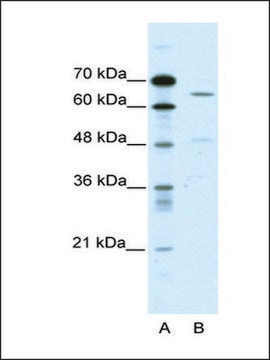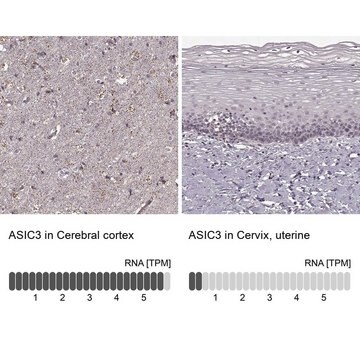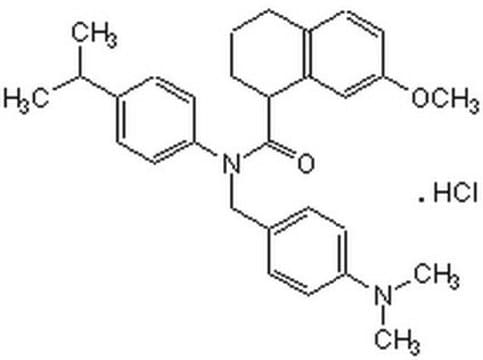AB5927
Anti-Acid Sensitive Ion Channel 3 Antibody, 285-304 of extracellular domain of rat ASIC3
Chemicon®, from guinea pig
동의어(들):
ASIC3, Amiloride-sensitive Cation Channel 3, TNaC1, Testis Sodium Channel 1, Dorsal Root Ganglion ASIC (DRASIC)
로그인조직 및 계약 가격 보기
모든 사진(1)
About This Item
UNSPSC 코드:
12352203
eCl@ss:
32160702
NACRES:
NA.41
추천 제품
생물학적 소스
guinea pig
Quality Level
항체 형태
affinity purified immunoglobulin
항체 생산 유형
primary antibodies
클론
polyclonal
정제법
affinity chromatography
종 반응성
rat
제조업체/상표
Chemicon®
기술
immunocytochemistry: suitable
immunohistochemistry: suitable
NCBI 수납 번호
UniProt 수납 번호
배송 상태
dry ice
타겟 번역 후 변형
unmodified
특이성
ASIC3 (DRASIC)
면역원
Epitope: 285-304 of extracellular domain of rat ASIC3
Synthetic peptide from the extracellular domain of rat ASIC3 (Catalog Number AG366). (C)TASLDPDDFDPEPSDPLGSP
애플리케이션
Detect Acid Sensitive Ion Channel 3 using this Anti-Acid Sensitive Ion Channel 3 Antibody, 285-304 of extracellular domain of rat ASIC3 validated for use in IC, IH.
Immunohistochemistry: 1:100
Immunocytochemistry: 1:100
Optimal working dilutions must be determined by the end user.
APPLICATION NOTES FOR AB5927
IMMUNOHISTOCHEMISTRY
Male Sprague-Dawley rats (b.wt. 100-150g) were anesthetized with sodium pentobarbital and perfused via the ascending aorta with: 1) 50 mL of Ca2+-free Tyrode+s solution followed by 2) a formalin-picric acid fixative (4% paraformaldehyde with 0.4% picric acid in 0.16 M phosphate buffer, pH 6.9) and 3) 10% sucrose in PBS as a cryo-protectant. Tissues were rapidly dissected out and stored overnight in 0.1 M phosphate buffer (pH 7.4) containing 10% sucrose. Slide-mounted tissue sections were incubated with blocking buffer for 1 hour at room temperature. Primary antibody was diluted in blocking buffer to the appropriate working dilution. Blocking buffer was removed and the slides were then incubated at 4°C for 18-24 hours with AB5927. After rinsing in PBS 3 times sections were incubated for 60 minutes at room temperature with Cy3-conjugated secondary antibodies. After mounting in a mixture of PBS and glycerol (1:3) containing 0.1% p-phenylenediamine, sections were examined with a Nikon Microphot-SA epifluorescence microscope.
Immunocytochemistry: 1:100
Optimal working dilutions must be determined by the end user.
APPLICATION NOTES FOR AB5927
IMMUNOHISTOCHEMISTRY
Male Sprague-Dawley rats (b.wt. 100-150g) were anesthetized with sodium pentobarbital and perfused via the ascending aorta with: 1) 50 mL of Ca2+-free Tyrode+s solution followed by 2) a formalin-picric acid fixative (4% paraformaldehyde with 0.4% picric acid in 0.16 M phosphate buffer, pH 6.9) and 3) 10% sucrose in PBS as a cryo-protectant. Tissues were rapidly dissected out and stored overnight in 0.1 M phosphate buffer (pH 7.4) containing 10% sucrose. Slide-mounted tissue sections were incubated with blocking buffer for 1 hour at room temperature. Primary antibody was diluted in blocking buffer to the appropriate working dilution. Blocking buffer was removed and the slides were then incubated at 4°C for 18-24 hours with AB5927. After rinsing in PBS 3 times sections were incubated for 60 minutes at room temperature with Cy3-conjugated secondary antibodies. After mounting in a mixture of PBS and glycerol (1:3) containing 0.1% p-phenylenediamine, sections were examined with a Nikon Microphot-SA epifluorescence microscope.
Research Category
Neuroscience
Neuroscience
Research Sub Category
Ion Channels & Transporters
Neuroinflammation & Pain
Ion Channels & Transporters
Neuroinflammation & Pain
물리적 형태
Affinity purified immunoglobulin. Liquid in PBS, pH 7.4 with 1% BSA and 0.05% sodium azide.
저장 및 안정성
Maintain at -20°C in undiluted for up to 6 months. Avoid repeated freeze/thaw cycles.
법적 정보
CHEMICON is a registered trademark of Merck KGaA, Darmstadt, Germany
면책조항
Unless otherwise stated in our catalog or other company documentation accompanying the product(s), our products are intended for research use only and are not to be used for any other purpose, which includes but is not limited to, unauthorized commercial uses, in vitro diagnostic uses, ex vivo or in vivo therapeutic uses or any type of consumption or application to humans or animals.
적합한 제품을 찾을 수 없으신가요?
당사의 제품 선택기 도구.을(를) 시도해 보세요.
Storage Class Code
12 - Non Combustible Liquids
WGK
WGK 2
Flash Point (°F)
Not applicable
Flash Point (°C)
Not applicable
시험 성적서(COA)
제품의 로트/배치 번호를 입력하여 시험 성적서(COA)을 검색하십시오. 로트 및 배치 번호는 제품 라벨에 있는 ‘로트’ 또는 ‘배치’라는 용어 뒤에서 찾을 수 있습니다.
R Waldmann et al.
Nature, 386(6621), 173-177 (1997-03-13)
Acid-sensing is associated with both nociception and taste transduction. Stimulation of sensory neurons by acid is of particular interest, because acidosis accompanies many painful inflammatory and ischaemic conditions. The pain caused by acids is thought to be mediated by H+-gated
Age-dependent sensitization of cutaneous nociceptors during developmental inflammation.
Jankowski, MP; Ross, JL; Weber, JD; Lee, FB; Shank, AT; Hudgins, RC
Molecular Pain null
Katherine J D A Excoffon et al.
Biochemical and biophysical research communications, 425(1), 13-18 (2012-07-20)
We have previously shown that the Coxsackievirus and adenovirus receptor (CAR) can interact with post-synaptic density 95 (PSD-95) and localize PSD-95 to cell-cell junctions. We have also shown that activity of the acid sensing ion channel (ASIC3), a H(+)-gated cation
자사의 과학자팀은 생명 과학, 재료 과학, 화학 합성, 크로마토그래피, 분석 및 기타 많은 영역을 포함한 모든 과학 분야에 경험이 있습니다..
고객지원팀으로 연락바랍니다.








